The big white house on a hill embarrasses me.

In the 1800 block of East Leuda Street—a block otherwise dotted with small, modest houses—this house has stood grandly—and patiently—for more than a century, waiting for me to notice it.
 According to its deed card, the house was built in 1907.
According to its deed card, the house was built in 1907.
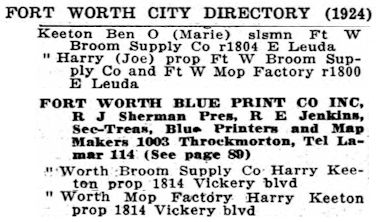 For most of the twentieth century the house was owned by the Keeton family.
For most of the twentieth century the house was owned by the Keeton family.
But there’s more. The big white house on a hill, near the intersection of Riverside Drive and Vickery Boulevard, once had as a back-door neighbor . . .
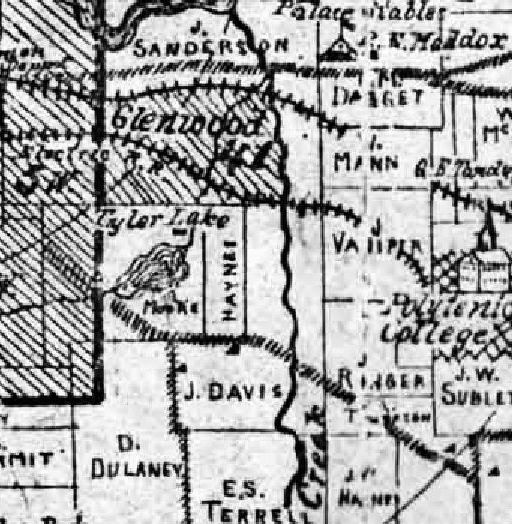 Tyler’s Lake. Ever heard of Tyler’s Lake? I grew up on the East Side and happily misspent my youth in nearby Sycamore Park and Sycamore Creek, but I had never heard of Tyler’s Lake until I noticed it on this 1895 county map. On this map the lake appears just outside the Fort Worth city limits between the Mansfield wagon road (diagonally hatched line) and the streetcar line (“Electric R.R.”) to Polytechnic. (Map from Pete Charlton’s “The Lost Antique Maps of Texas: Fort Worth & Tarrant County, Volume 2” CD.)
Tyler’s Lake. Ever heard of Tyler’s Lake? I grew up on the East Side and happily misspent my youth in nearby Sycamore Park and Sycamore Creek, but I had never heard of Tyler’s Lake until I noticed it on this 1895 county map. On this map the lake appears just outside the Fort Worth city limits between the Mansfield wagon road (diagonally hatched line) and the streetcar line (“Electric R.R.”) to Polytechnic. (Map from Pete Charlton’s “The Lost Antique Maps of Texas: Fort Worth & Tarrant County, Volume 2” CD.)
 J. L. Tyler was born in Michigan in 1845. By 1880 he was farming in rural Fort Worth. In 1884 he bought Lake Park just southeast of town with plans to enlarge the lake and add amenities. And he did, as clips from the Fort Worth Gazette of the 1880s and 1890s show. Tyler’s Lake and its park became a popular recreational area in Glenwood, an unincorporated community centered about where the big white house on a hill stands today.
J. L. Tyler was born in Michigan in 1845. By 1880 he was farming in rural Fort Worth. In 1884 he bought Lake Park just southeast of town with plans to enlarge the lake and add amenities. And he did, as clips from the Fort Worth Gazette of the 1880s and 1890s show. Tyler’s Lake and its park became a popular recreational area in Glenwood, an unincorporated community centered about where the big white house on a hill stands today.
 J. L. Tyler was one of two dominant forces who shaped Glenwood. The other was Richard L. Vickery. By 1887, as Tyler was developing his Tyler’s addition west of his lake, R. Vickery was beginning to buy and sell land, especially in the Moore survey. And where was the Moore survey?
J. L. Tyler was one of two dominant forces who shaped Glenwood. The other was Richard L. Vickery. By 1887, as Tyler was developing his Tyler’s addition west of his lake, R. Vickery was beginning to buy and sell land, especially in the Moore survey. And where was the Moore survey?
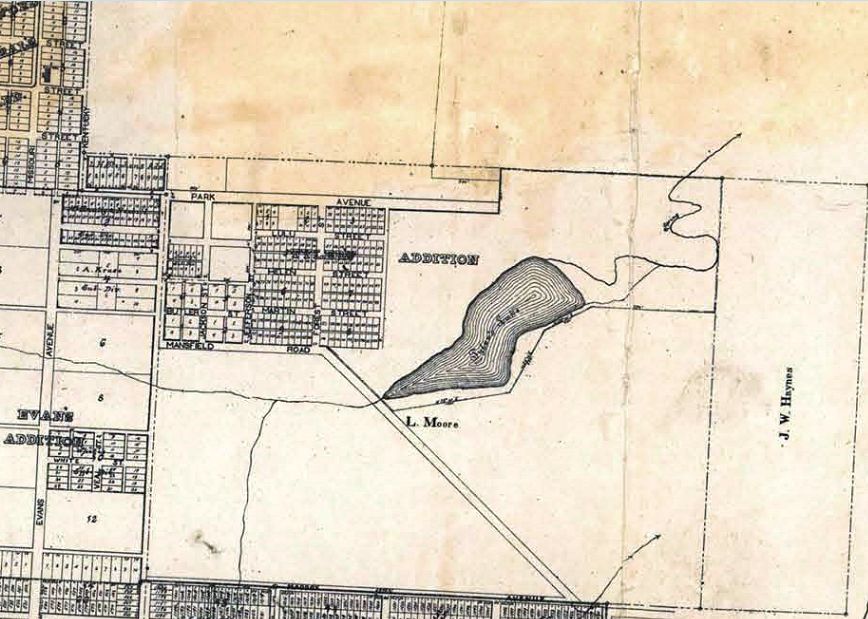
The Moore survey included Tyler’s addition, Tyler’s Lake, and much of the future community of Glenwood. This map is from 1890. The lake was fed by a creek from the west. Overflow from the lake’s dam fed Sycamore Creek to the northeast. (From Pete Charlton’s “The Lost Antique Maps of Texas: Fort Worth & Tarrant County, Volume 2” CD.)
 Richard Vickery was born in England in 185o. By 1880 he was living in Waxahachie and working as a confectioner.
Richard Vickery was born in England in 185o. By 1880 he was living in Waxahachie and working as a confectioner.
But about 1887, while still living in Waxahachie, Vickery began developing real estate in Glenwood. By 1895 Vickery’s Glenwood had 150 homes, 750-1,000 residents, its own school district, a six-room schoolhouse, three churches, and an artesian well. Vickery Boulevard, the main drag connecting Glenwood to Fort Worth, was “eighty feet wide and well graveled.”
By 1895 a streetcar line on Vickery Boulevard connected Glenwood to downtown Fort Worth and to Polytechnic College (TWU) to the east.
 Ad is from the 1907 city directory.
Ad is from the 1907 city directory.
 By 1903 Glenwood was a thriving community. Glenwood residents that year voted on incorporation but rejected it, preferring to hold out for annexation by Fort Worth. Clip is from the December 13 Telegram.
By 1903 Glenwood was a thriving community. Glenwood residents that year voted on incorporation but rejected it, preferring to hold out for annexation by Fort Worth. Clip is from the December 13 Telegram.
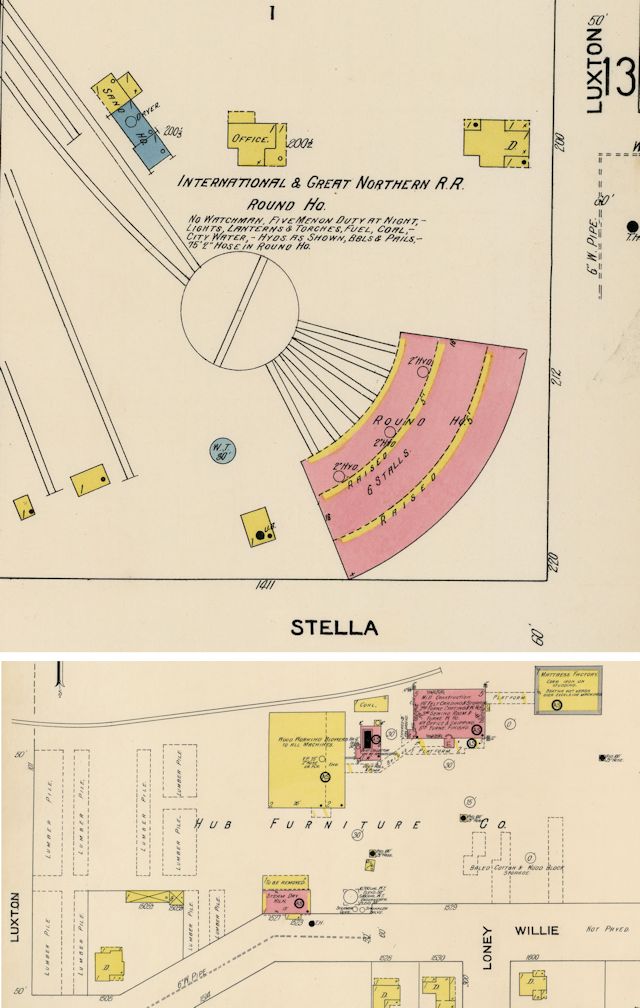 Also in 1903 Glenwood became the home of International & Great Northern railroad’s local facility, located on Luxton Street just north of Vickery Boulevard. On the other side of Luxton Street was the Hub furniture factory.
Also in 1903 Glenwood became the home of International & Great Northern railroad’s local facility, located on Luxton Street just north of Vickery Boulevard. On the other side of Luxton Street was the Hub furniture factory.
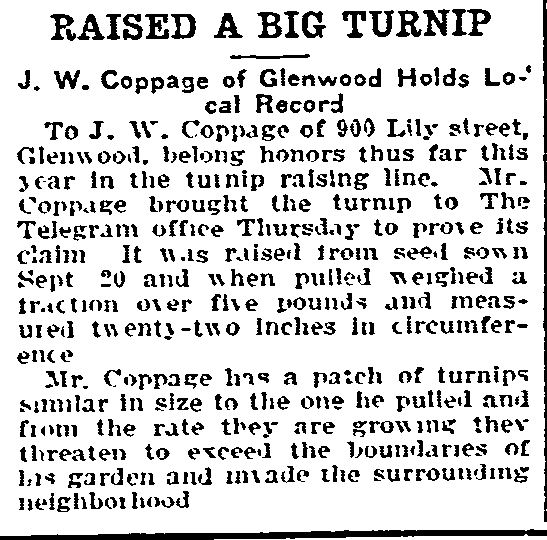
As this 1906 Telegram clip shows, suburban Glenwood was a hotbed of horticulture.
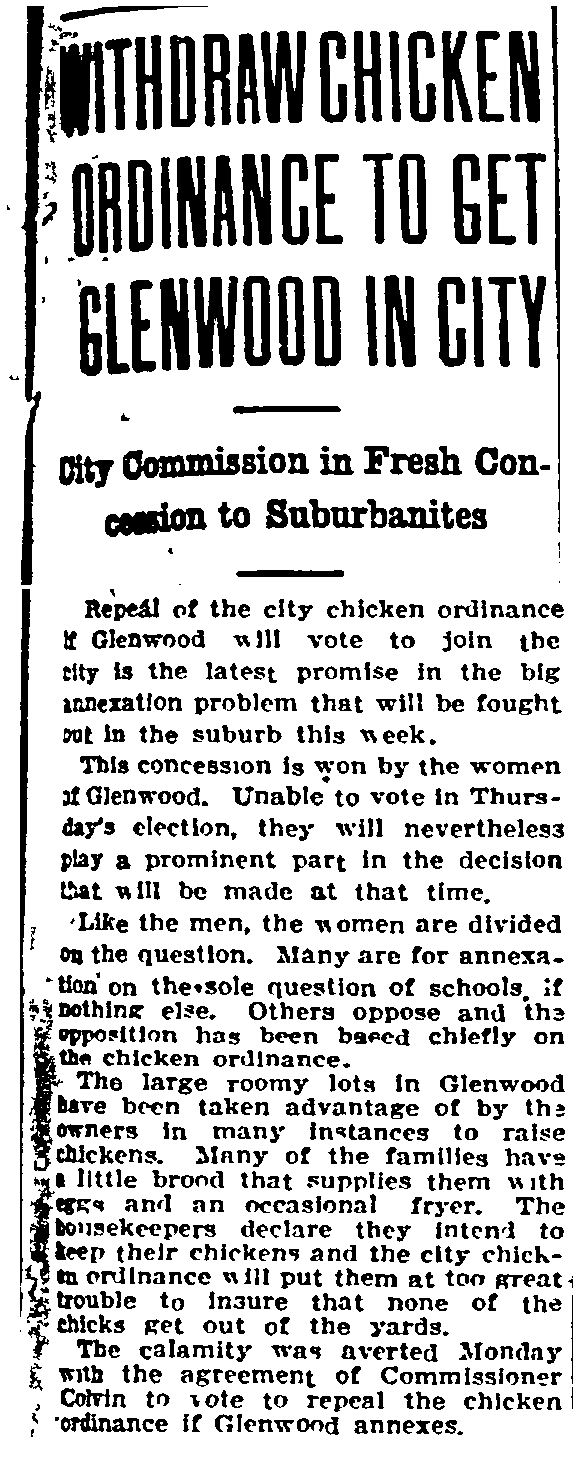 Finally, after prolonged negotiations between Glenwood and Fort Worth over annexation, in 1908 Fort Worth sweetened the (chicken) pot: It offered to withdraw “the chicken ordinance” if Glenwood would become part of Fort Worth.
Finally, after prolonged negotiations between Glenwood and Fort Worth over annexation, in 1908 Fort Worth sweetened the (chicken) pot: It offered to withdraw “the chicken ordinance” if Glenwood would become part of Fort Worth.
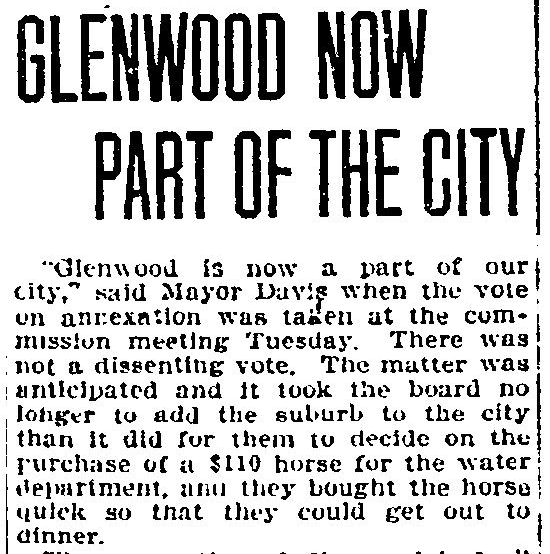
After the feathers had finally settled and the last souffle had fallen, Fort Worth indeed did annex Glenwood and its school on June 29, 1909. Clip is from the June 29, 1909 Star-Telegram.
 Later in 1909 the Star-Telegram published a report on the educational facilities of Fort Worth, including the new high school, new ward schools, and the new twelve-room Vickery school. In 1910 Fort Worth built R. Vickery School at a cost of $42,000 ($1 million today) on—where else?—Vickery Boulevard.
Later in 1909 the Star-Telegram published a report on the educational facilities of Fort Worth, including the new high school, new ward schools, and the new twelve-room Vickery school. In 1910 Fort Worth built R. Vickery School at a cost of $42,000 ($1 million today) on—where else?—Vickery Boulevard.
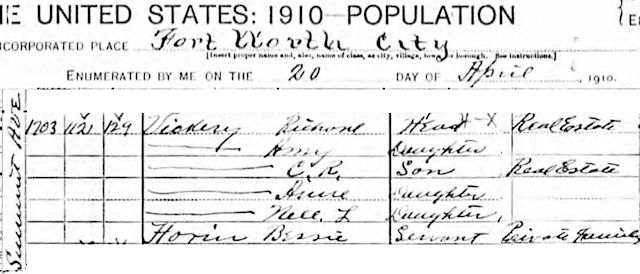 By 1910 R. Vickery was a wealthy man, living on Summit Avenue on Quality Hill.
By 1910 R. Vickery was a wealthy man, living on Summit Avenue on Quality Hill.
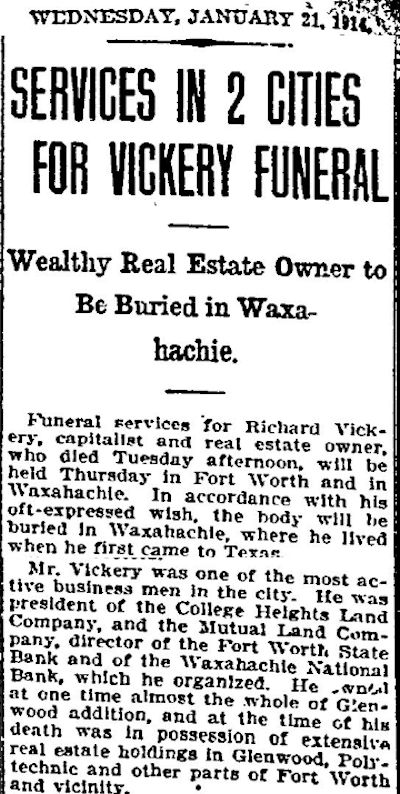 R. Vickery died in 1914. By then he was back on the East Side, living on Conner Avenue in Poly.
R. Vickery died in 1914. By then he was back on the East Side, living on Conner Avenue in Poly.
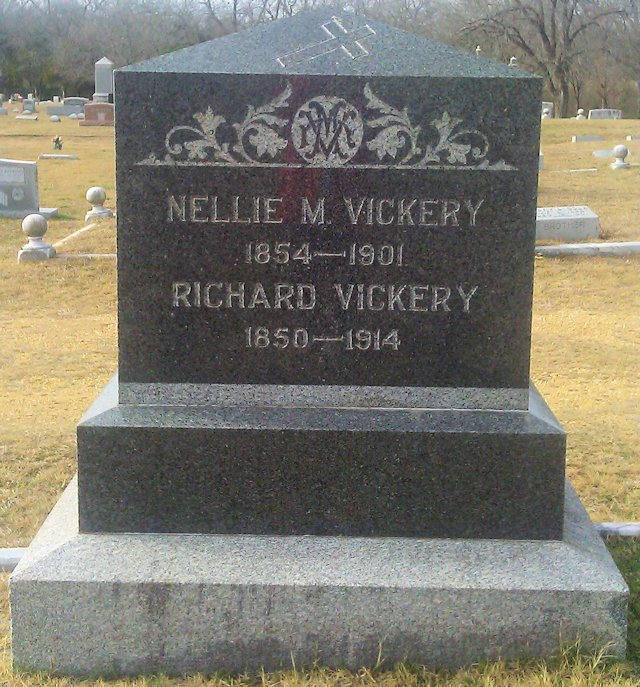 He is buried in Waxahachie.
He is buried in Waxahachie.
 J. L. Tyler sold his lake and park to the Ku Klux Klan, which was very active in Fort Worth in the early 1920s. But in 1923 Fort Worth parks superintendent George C. Clarke announced that the city had bought the park from the KKK to dedicate as a park for African Americans. White people in the area protested, and the city backed down.
J. L. Tyler sold his lake and park to the Ku Klux Klan, which was very active in Fort Worth in the early 1920s. But in 1923 Fort Worth parks superintendent George C. Clarke announced that the city had bought the park from the KKK to dedicate as a park for African Americans. White people in the area protested, and the city backed down.
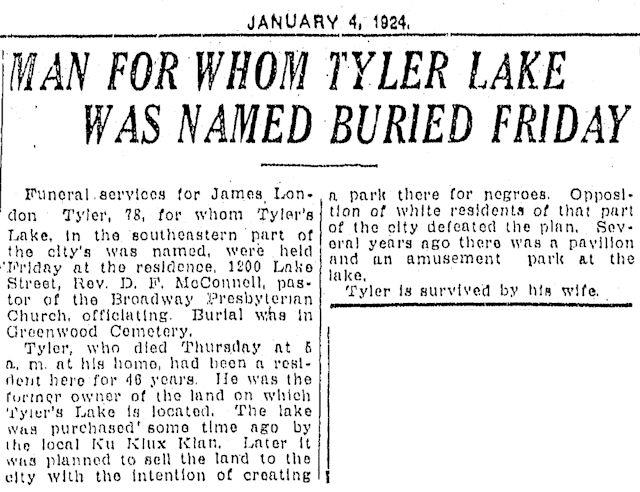 James London Tyler died in 1924.
James London Tyler died in 1924.
 The city sold the lake to Joe B. Willis, who in 1925 agreed to drain and fill in the lake as a precaution against mosquitoes. The Star-Telegram article referred to the lake as Fort Worth’s “original pleasure resort” with a pavilion and dance hall (predating Rosedale Pavilion, the first of Fort Worth’s four trolley parks).
The city sold the lake to Joe B. Willis, who in 1925 agreed to drain and fill in the lake as a precaution against mosquitoes. The Star-Telegram article referred to the lake as Fort Worth’s “original pleasure resort” with a pavilion and dance hall (predating Rosedale Pavilion, the first of Fort Worth’s four trolley parks).
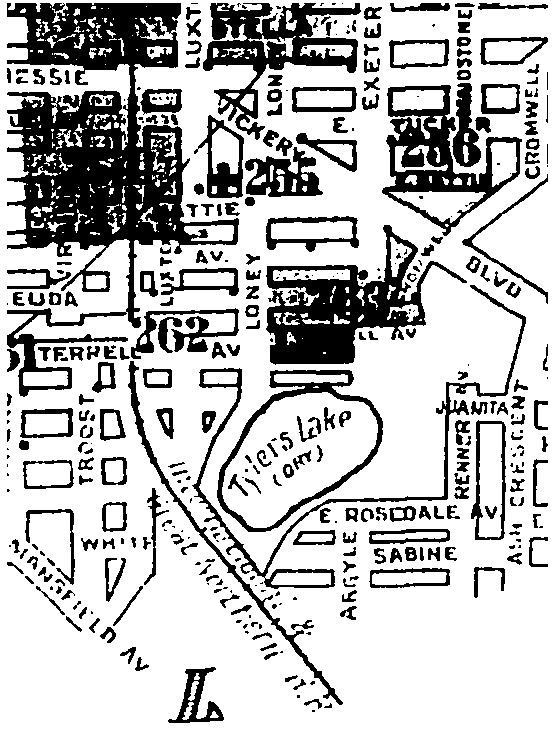 By 1927 a Sanborn map labeled Tyler’s Lake as “dry.” By 1929 the lakeless park was again a Fort Worth city property and had become Glenwood Park.
By 1927 a Sanborn map labeled Tyler’s Lake as “dry.” By 1929 the lakeless park was again a Fort Worth city property and had become Glenwood Park.
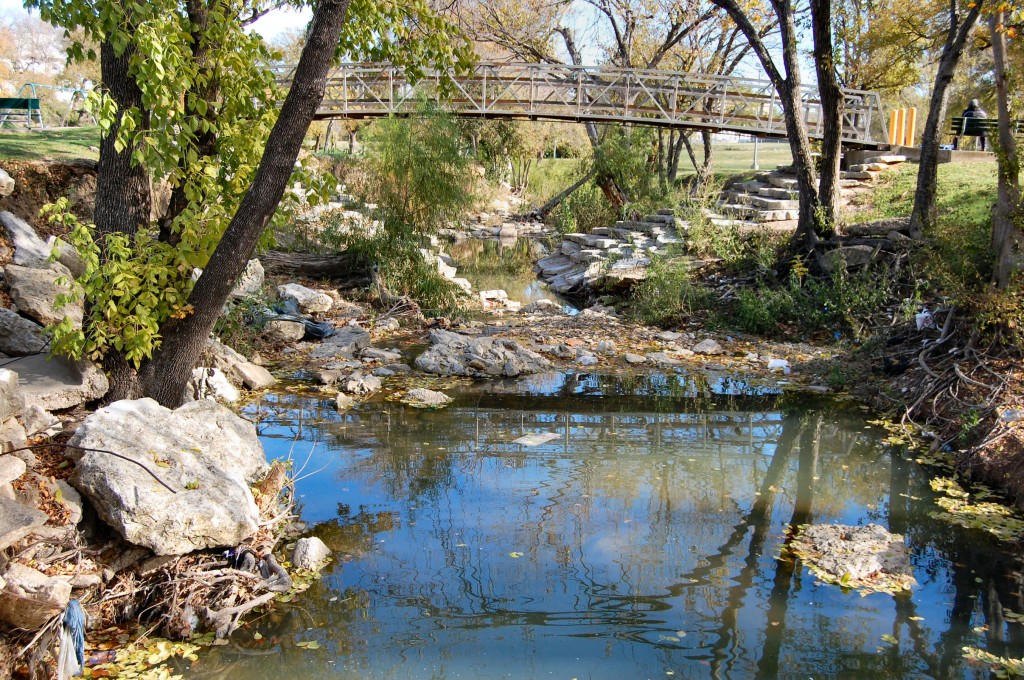
But the nameless creek that fed Tyler’s Lake still flows over the limestone of the park where the lake was, still flows under Vickery Boulevard and past R. Vickery School and into Sycamore golf course, where it merges with Sycamore Creek. That “large grove with plenty of shade” of 1884 still stands. The big white house on a hill of 1907 that waited more than a century for me to notice it still commands the hillside just to the north.
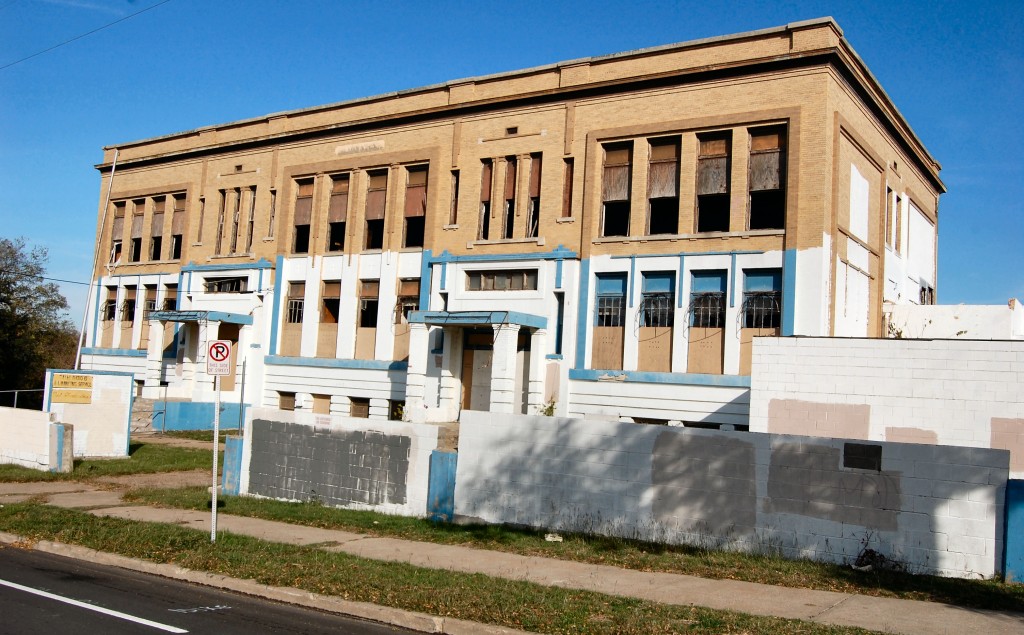
But now the R. Vickery School of 1910 sits all blue and abandoned. And Tyler’s Lake and the town of Glenwood of the 1890s are just ghosts on an old map.
Glenwood’s neighbor to the north:
North Glenwood: Little Island of Anonymity
More on Glenwood:
Cowtown Yoostabes, Glenwood Edition: From Furniture to Forgings
Kansas, Quantrill, and the Not-So-Vacant Lot on Stella Street
All Aboard the I&GN for Everman, Venus, Maypearl, Waco, and Points South
Other “lost lakes” of Fort Worth:
From Katy to Tandy to Togo: The Lost Lakes of Cowtown






My mother, Lucy Helen Russell, attended R. Vickery School in about 1927 or 1928. Would love to see any class photos.
If J. Tyler stands for John Tyler, the site might be much more older. The question is, a path for Mr. John Tyler Sr. or Mr. John Tyler Jr.
https://www.nga.org/governor/john-tyler-sr/
https://encyclopediavirginia.org/entries/tyler-john-1790-1862/
Tyler’s Lake was the site of the annual Texas Spiritualist Camp Meetings, each lasting about two weeks in the Fall, beginning in 1893, I think. Spirit mediums, “materializations,” trance “ tests, Chautauqua-like lectures, and plenty of commercial hawking of barbecue, popcorn, lemonade, Kinetoscopes, phonographs, etc.
Thank you for visiting the site. Unfortunately the author, Mike Nichols, passed away and we are working on how best to preserve this informative site.
Hey Mike! I love your work. I am the new owner of 1800 E Leuda, along with two other partners. We grew up in Fort Worth and have been attempting to make our mark on it by buying these old homes and bringing them back to life. Would you be able to email me the deed cards you found for this home? Would be an interesting piece of history to have. Hope all is well!
Thank you, Mr. Goytia. I have e-mailed you the deed cards.
Very Interesting and most informative. Makes me want to search some of these places out!
Your surname is a household word on both sides of town.
This is so awesome :’)
Thank you, Shoni.
I have unfortunately lived inside this school and was a resident there until last year” I am still homeless and living close by as I still study the school and it’s inhabitants that are not visible!! And please whatever you do? Do not go into the building itself because it will run you out”
Thank you, Thank you, Thank you for making this history available. My grandparents, Joseph R. and Lilly Virginia (Maxey) Gurley lived in the 1700 block of East Vickery in the 1910 census.
A few years later they purchased 2 1/2 lots on the north side of E. Vickery, 1601 & 1615 E. Vickery Blvd.
My granddaddy’s business Gurley Feed & Fuel was built on 1601 & their 5-bedroom, living room, dining room & kitchen home was built by him.
My mother, Esther Ruth, was born there in 1913. She was the last of 9 children. Sadly infant twins passed away. A son Maxey passed away in 1906. He is buried in Oakwood Cemetery on the North Side.
TAD.org mistakenly lists the year their home was built as 1921. That is impossible because Granddaddy passed away in November, 1917 as a result of an accident involving his favorite horse Jake. The Gurley family owned & occupied their home until 1995. Only 2 other families have owned
the home from then until the present day.
I know for certain that Mother and 3 of her
older siblings attended R. Vickery Elementary.
Bother Mother & her brother Lee graduated from
Polytechnic High School.
My father Melvin Clyde Arnold, son of Henry Allen & Elizabeth Jane (Shaw) Arnold also attended R. Vickery. As did I for grades 1-4 (1947-1951)
Like Mother and her brother Lee, I also graduated from William James Junior High School and Poly High (1958). Mother and I dearly loved those schools.
She was, as am I, deeply saddened by the closing
of R. Vickery, my all time favorite school, and it’s deterioration. What a waste of a building that had wonderful teachers who provided us with
a great foundation for our future education. I
continuously hope for someone to buy and restore
R. Vickery and put it to good use for the community.
As to the white house on the hill - on the corner
of Riverside Dr. - the Keeton family owned it from the early 1900’s until probably the 1970’s. They and Mother’s family were very good friends all those years. Mr. Keeton established a mattress
factory and wholesale fabric business on E. Vickery in the red brick warehouse area immediately east of I35. The Keeton name is
still there.
Their youngest son started R. Vickery just a year ahead of me so that we both graduated from William James & Poly High.
Thank you for your Glenwood memories. A bit more on Mr. Keeton at https://hometownbyhandlebar.com/?p=17719
Did you go to R.Vickery School in 1947. I was in 5th grade.I have the 5th grade class picture. I will send it to you, if you are interested. What is your email address. Are you on Facebook? All the best, Roy Mills
Roy, I went to D. McRae Elementary in Poly 1956-1961. I probably knew some kids from R. Vickery at William James Junior High.
Ran across this while researching another address. As a kid, going to my great-grandmother’s house, we passed this house often and I always wondered about it. 40 something years later I have my answers!
Thank you for making this information available.
Hi Juanita my last name is Rigsby also and I grew up looking at this house in the 1960s when I went to R. Vickery elementary School which was just down the street. I actually knew the family who lived in this big white house at that time and went to school with the children that lived there. it was always an interesting house to me to. Thanks for sharing a memory..
I attended R. VICKERY from 1st thru 4th grades (1948-52). Beautiful three-level playground with creek on lowest level. Best Easter Egg Hunts and Halloween Carnivals.
I hope that school building can find a new purpose in life and remain standing. Every time I drive past it I want to buy it and fix it up.
The Keeton Family home that you refer to is now, and has been most (if not all) of my life been owned by Bobby and Mattie Edwards. Bobby worked as a Sears repair man; We always saw the Sears van parked in the driveway. He also taught his sons the art of upholtery, which they did in the garage shop on the property. In my teen years, I also knew him to refurbish properties in the neighborhood. The Edwards family still occupies the home, although Mattie died around 2015.
I played at the house with their sons Nathan and Doug. I went to R. Vickery School from 1st - 3rd grades. In 6th grade, I went to William James, and stopped by the house to pick up Nathan every morning with our friends. The family, like the majority of the families that I grew up around in the neighborhood (my family lived at, and still owns 615 Loney, which I believe was built in 1922) was a wholesome family. If we were ever over playing after school, Mrs. Edwards was clear that 6 pm was time for dinner and we knew it was time for us to get home.
I heard rumblings from my mother about “the area” being “under water” or “a lake” at some point but never had any proof. I played in the park and developed as a boy in all of Glenwood. I even remember walking from Glenwood park through the creek tunnel back to R. Vickery (of course my family never knew of this).
For the past 31 years I have lived in New England (Connecticut and Massachusetts) and bring my family back to Fort Worth regularly. My children know of Glenwood as the Southside, which is what we called it growing up. I see my childhood in the area through Sawyer/Finn lenses. We raced and played football in the streets and at the Park. My sister taught me how to play basketball at the Hattie Street Haven (The old fire station converted to a community center). Everyone knew everyone. During pecan season, we threw sticks into the pecan trees to knock down and eat the huge pecans. What started out as a place that was not intended for African Americans holds fond memories for many of us who grew up there. It was a proud and respectful community. To be clear, the neighborhood was diverse. Mr. and Mrs. Michals lived across the street from us (they were an older white couple that were our neighbors). There also remained white families on Vickery and a more concentrated group on Stella. There were also Mexican families living in the community.
Thanks for your work. One thing that I have often wanted to know is who lived on Loney Street, and especially in the house that I grew up in at 615 Loney Street. Any recommendations on where I might find information on this?
Dr. Mays, I have e-mailed you city directory listings and deed cards. Thanks for sharing your memories. Growing up in Poly, it was fun to learn more about the area.
When I was growing up in Poly in the 1950’s, we knew the Keeton family who lived in the old white house. My dad, Henry Hearne used to work for Mr. Keeton in the 1940’s at Keeton’s Supply, which was, I believe on Vickery.
My dad started Hearne Wrecking & Lumber Co. at 2466 South Riverside Dr. in 1949. Have you ever found any old pictures of that place? I enjoy your blog.
Thanks, Lindy. I have never seen photos of the Riverside Drive property. Now and then the Star-Telegram ran photos of Hearne workers dismantling a building. And WBAP-TV ran a couple of news clips of the same nature. The Hearne Wrecking Company newspaper ads, as you know, were always small classifieds with no illustrations.
Do you have any information about the early distribution of water to Glenwood? My grand parents and other extended family owned property on Stella street. The artesian well on the home place provided water they delivered by horse drawn wagon to their neighbors. Trantham is the family name.
Judy, I have e-mailed you some clips.
This blog is wonderful! Glenwood Park is in City Council District 8 and I work for the Councilmember Kelly Allen Gray. This coming Memorial Day, there will be a Historic Southside neighborhood picnic at 11:00 am. Your blog has given everyone thoughtful look back and an additional reason to celebrate.
Maribeth: Thank you so much. Having grown up on the East Side, I had great fun learning the history of Glenwood and North Glenwood.
Absolutely fascinating. And I love reading about others memories of Glenwood. Sure would like to know if there are any books about any of fort worth’s “lost cities, lakes, or parks”. I love fort worth history! 🙂
Thank you. This blog has a lot of information on those subjects. The 900 posts can be searched by category or keyword. (All of the information in Lost Fort Worth is in the blog.) Elsewhere there are books about Fairmount, North Side, Arlington Heights, and Oakhurst. Susan Kline wrote a book about Fort Worth parks. Having grown up in Polytechnic, I have several posts on the history of that incorporated city/part of town. I also have a post about lost lakes of Fort Worth.
My parents lived in Glenwood from 1946 thru 1970 on Stella St. I went to R. Vickery, William James & Poly…graduated in 1961…Never heard of the lake…but my sisters &I played in Glenwood Park & went to church at South Riverside Baptist Church…Harold George Keeton lived in the big white house…There was an old dog pound located somewhere around or in the old park at one time because when we followed the creek west a ways we found an old torn down building & there was alot of animal bones & hair…I was about 7 or 8 so in must of been 1949/1951.
Growing up farther east, for me Glenwood was just an area we passed through at Vickery and Riverside Drive going west. I had never heard the name or seen the lake on an old map until I got interested in Fort Worth history and started digging.
Ruby,
There was an animal pound exactly where you found the bones and old building.
My horse was picked up so often the dog catcher would just keep him until I started looking for him. He would, however, make me pay for hay.
I was born (1934) and raised at 1615 E. cannon my grandparents, aunts, uncles, cousins all lived within two blocks of us. My granddad was the local butcher…
Ronnie
I was also raised in Glenwood. I remember living on Stella St, Luxton st and Ave C. I went to R Vickery from 1952 -1958. I have never heard of Tyler Lake. This is very interesting. Thanks for posting.
Thanks, Janet. Like you I grew up on the East Side and was not aware of Tyler Lake. Or even Tandy Lake (https://hometownbyhandlebar.com/?p=1299). Heck, I was thirty-five before I knew about Echo Lake, which is still there.
I attended R. Vickery Elementary School 1950 to 1952. My first grade teacher was Mrs. Willace and my second grade teacher was Mrs. Cherry.
Hope that school building will survive. Pretty forlorn now.
I was born and raised at 1615 E Cannon St. in Glenwoood. My parents were also raised in Glenwood. My Grandmother bought the house around 1924. I attended R.Vickery, William James and Poly. Being from Glenwood we were never accepted by the Poly kids. We were mostly considered outsiders. My friends and I spent many hours in Glenwood park and on an over night camping trip we managed to set the whole park on fire. Since my father was a Fort Worth firemen I was in deep trouble. I never knew about the Lake but I remember my parents telling me they used to have dances there. Glenwood was a great place to grow up. My wife, Betty who also lived right off of Riverside Dr and Rosedale were married April 28, 1951. We now live in CADDO MILLS, tX.
Mr. Westmoreland: I grew up in Poly and knew nothing of Glenwood, even though I spent a lot of time in nearby Sycamore Creek and Park. It was fun to discover Glenwood’s “lost” past.
I attended Poly from 1949 to 1951. I was not a good student but had a lot of fun. I played football, where I was certainly not outstanding. I kept my horse staked out in Glenwood Park on occasion. The rest of the time either in my back yard or in a pasture on the Trinity River. I spent a lot of my time hanging around the stockyards and wrote about some of those adventures in a book titled REMEMBER THAT OL’ HORSE? Since that first book I have written and published five more. All are available through amazon.com and other online booksellers. Being born in 1934, Fort Worth was a great place to grow up. I have nothing but good memories. When did you attend Poly?
Ronnie
Mr. Westmoreland:
Thank you for sharing your memories. You were hanging around the stockyards about the time my father worked there. You were at Poly High when Bert Tandy, a great-grandson of East Side pioneer Roger Tandy, was there. I graduated from Poly High in 1967.
Great post!
Thanks, Paul.
Are chickens still allowed?
Steve, I think the current ordinance allows twelve hens and two roosters on a half-acre or less.